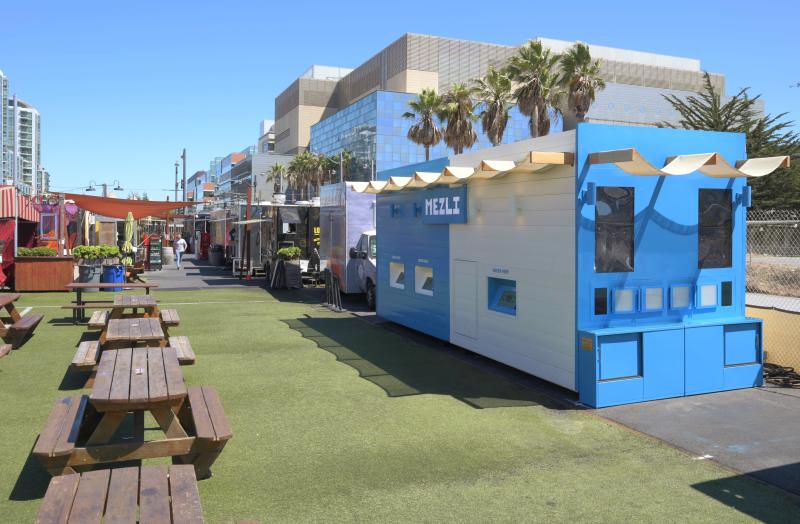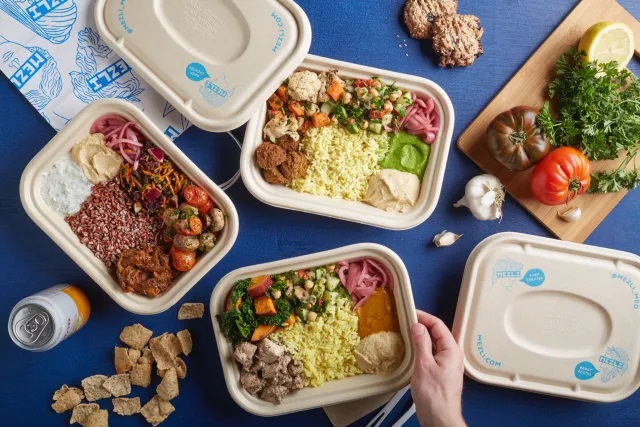Robot Restaurant
In San Francisco’s SPARK Social food court, diners walk up to a shipping container-sized building that has a touchscreen on it. They select a meal from a long list of Mediterranean-style bowls: shredded spiced lamb with tzatziki, lemon za’atar chicken, or a falafel bowl with salad — the potential ingredient combinations reach into the thousands. Inside the building, each bowl travels on a conveyor belt as robots heat and dispense the specified ingredients into the bowl. The finished product ultimately ends up at a window where customers can grab it and go. The only part of the food-making process that humans are involved in is the preparation of the ingredients. This is conducted in a central kitchen, where a large space allows Mezli cooks to prepare food at scale and then deliver it to the restaurant site. It’s similar to a regular restaurant: The main difference is that the cooks are ultimately delivering food to robotic servers (or, more accurately, robotic food assemblers) rather than human waiters. Once the food is prepared, Mezli staff deliver it to the restaurant, which looks like a pleasant, if small, eatery — except there’s no front door. And there are no humans inside. The restaurant industry has always been a fairly difficult one for most people involved. The hours can be terrible, the pay is often low, turnover can be very high, and the profit margins often leave something to be desired — if the business lasts long enough to turn a profit. For restauranteurs, tasking robots with food preparation can significantly cut costs. “Better quality of life for the staff, more approachable hours or more manageable hours, and just not that hectic hustle and bustle and grind.” “With the robot, the only thing is, ‘Is it full or is it not and what does it need?’ And as long as we’re always prepared, we can always meet that.”
In May 2022, the industry was down about 750,000 jobs — or about 6% of the workforce — compared to pre-pandemic levels, according to the National Restaurant Association. Many of those lost jobs comprise roles like dishwashing, serving, and food preparation. If more restaurants were able to save money by automating these positions, they could potentially provide staff with better conditions and higher pay. But despite reports suggesting that robots could replace as much as 80% of restaurant positions, it’s unlikely that restaurants (especially sit-down spots) will fundamentally change anytime soon. After all, there are certain things a machine just can’t do.
“We still want to have those date nights and those birthday dinners and to get together with friends at the bar and talk to the bartender,” Minnich said. “Robots won’t ever really have that human touch in the sense — they won’t have hospitality in the true sense of the word.”
The links below imitate or illustrate a robot restaurant:
Humor here – You will laugh
A robot tried to rob a bank but was caught when its battery died.
Police have no plans…to charge the suspect.
Why are so many robots progressive?
Many of them have transistors.
Why did the robot cross the road?
It was programmed by the chicken.
What do you call a blonde who’s dyed her hair brunette?
Artificial intelligence.
June 18th Birthdays
1992 – Willa Holland, 1948 – Ivonne Coll, 1952 – Isabella Rossellini, 1952 – Carol Kane
1913 – Sammy Cahn, 1960 – Christopher Lloyd, 1972 – Blake Shelton, 1980 – David Guintoli




